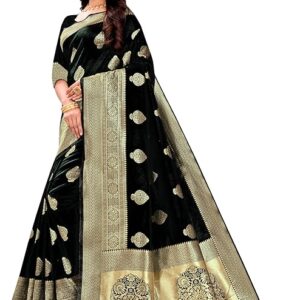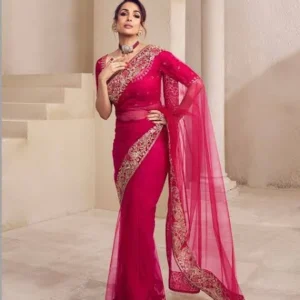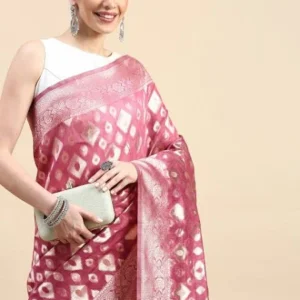A Women’s Printed Silk Blend Saree is a stunning fusion of traditional elegance and modern comfort. Let’s dive deeper into the specifics of this beautiful garment:
1. Fabric Composition:
-
Silk Blend: A silk blend saree combines the luxurious shine and softness of silk with other materials like cotton, polyester, nylon, rayon, or viscose. These additional fabrics make the saree lighter, more durable, and easier to manage compared to pure silk sarees. The blend can provide the luxurious feel of silk while maintaining practical aspects like easy maintenance, affordability, and better drape.
-
Advantages of Silk Blends:
-
Lightweight: Compared to pure silk, silk blends are typically more breathable and lightweight, making them more comfortable to wear for long hours.
-
Durability: Silk blends tend to be more durable than pure silk, as they are less prone to tearing or fraying.
-
Cost-Effective: They are more affordable compared to 100% pure silk sarees, offering a similar aesthetic at a lower price.
-
2. Prints and Patterns:
-
Floral Prints: One of the most popular types of prints for silk blend sarees, floral patterns range from delicate small flowers to large, bold floral designs. They give the saree a feminine and fresh look.
-
Paisley and Ethnic Designs: Paisley prints are often used to create a rich, traditional feel. Ethnic or tribal-inspired patterns often incorporate geometric shapes, motifs, and nature-based designs.
-
Geometric and Abstract Prints: Modern styles may feature bold geometric or abstract prints, giving the saree a contemporary twist.
-
Digital Prints: Advanced printing techniques, like digital printing, allow for more intricate and precise designs. These prints can range from landscapes, animals, and abstract art to more traditional motifs.
3. Saree Structure:
-
Blouse: A printed silk blend saree usually pairs with a matching or contrasting blouse. The blouse can be tailored in various styles like boat neck, v-neck, high neck, or halter neck. Printed blouses or solid-colored ones are popular choices.
-
Pallu: The pallu (the end portion of the saree that is draped over the shoulder) often features more elaborate or detailed designs to create a striking effect.
-
Borders: The borders of silk blend sarees can be either simple with a metallic or solid color trim or more intricate with zari (metal thread) work, embroidery, or prints.
4. Occasions:
-
Festivals: The vibrant colors and prints make silk blend sarees ideal for festivals like Diwali, Eid, Navratri, or Holi.
-
Weddings and Celebrations: They are also a popular choice for wedding guests, receptions, or anniversary celebrations because of their versatility and beauty.
-
Formal Events & Parties: A printed silk blend saree can be styled for a more modern, sleek look at a formal gathering, charity event, or evening party.
5. Color Palette:
-
Bright and Bold Colors: Printed silk blend sarees often come in rich, vibrant colors like red, orange, pink, and royal blue, perfect for festive occasions.
-
Pastels and Subdued Tones: For a more elegant, understated look, lighter shades like peach, lavender, cream, and mint are also common.
-
Dark Tones: Black, navy blue, and dark green are also favored for evening events, lending an air of sophistication.
6. Draping Styles:
-
The way the saree is draped can change its overall look. While the traditional Nivi drape is the most common, modern interpretations include Gujarati drape, Maharashtrian drape, or even a more contemporary Pant-style saree drape.
-
A lehenga-style drape is becoming popular, where the pleats are tucked into a waistband, creating a more voluminous and structured silhouette.
7. Styling and Accessories:
-
Jewelry: The right jewelry can elevate the look of a printed silk blend saree. Pair with traditional gold or diamond jewelry for weddings and festive occasions, or opt for statement pieces like chunky earrings, necklaces, or bangles for modern parties.
-
Footwear: Traditional footwear like mojris or kolhapuris can match the look, while stilettos or block heels might be chosen for formal events.
-
Hairstyles: From traditional buns adorned with flowers to sleek, straight styles or soft curls, the choice of hairstyle can complement the saree’s vibe.
8. Care and Maintenance:
-
Washing: Most printed silk blend sarees are hand wash or dry clean only. Since the fabric is not pure silk, it can be washed with care at home in cold water, but dry cleaning will ensure the longevity of the print and fabric.
-
Ironing: Ironing should be done on a low heat setting, with a cloth placed between the iron and the saree to prevent any damage to the fabric or print.












Reviews
There are no reviews yet.